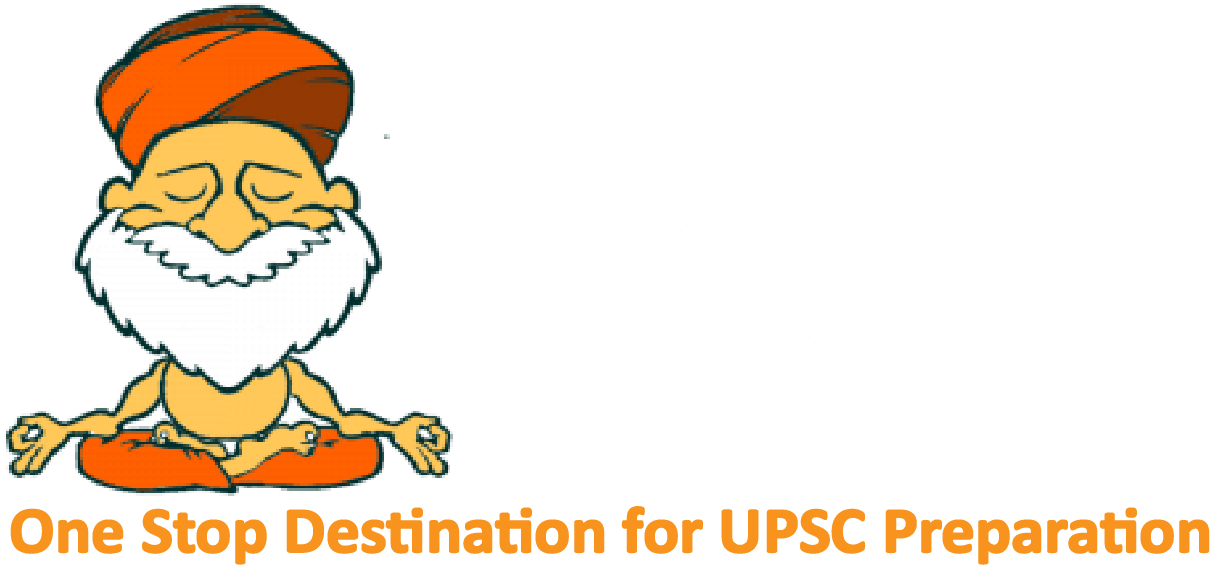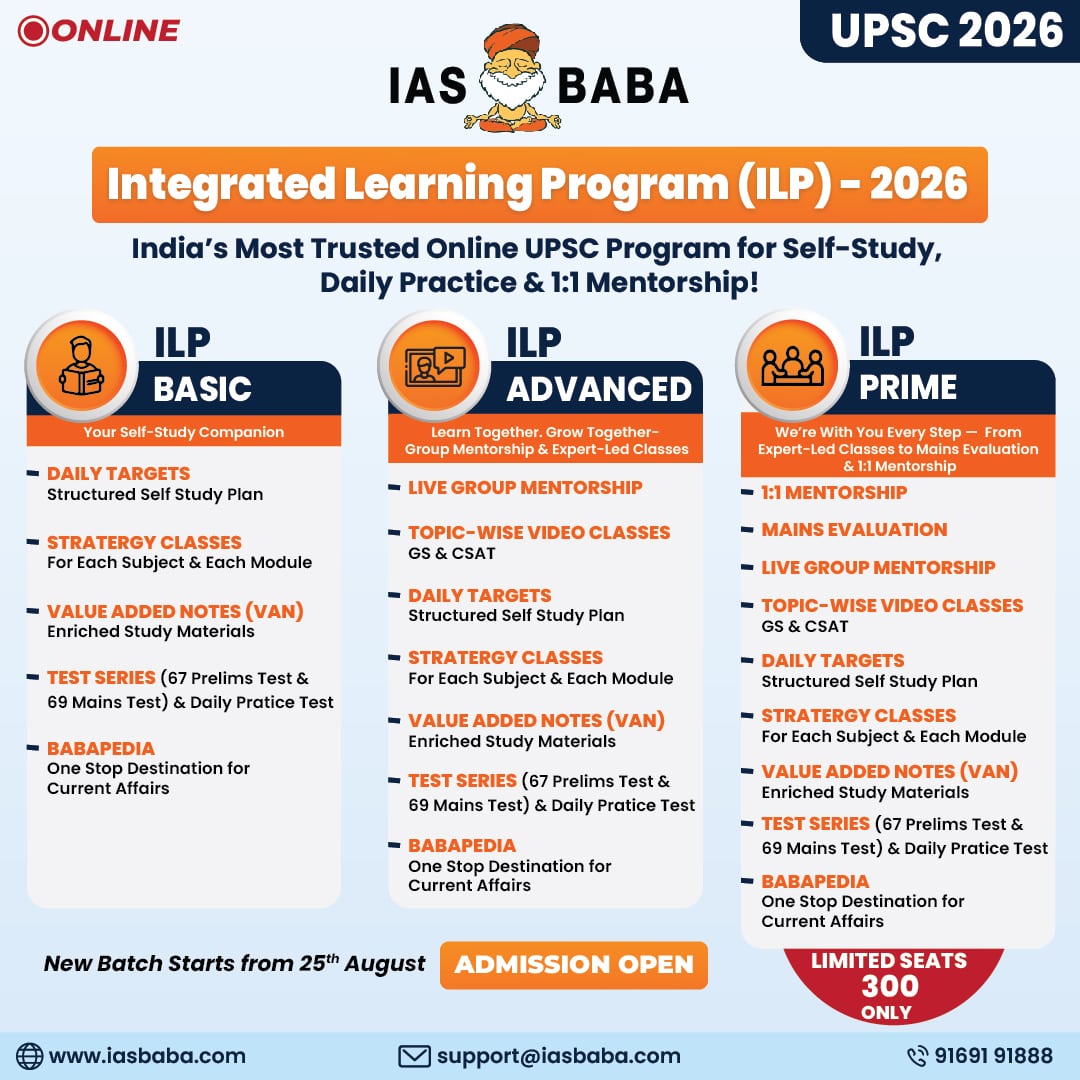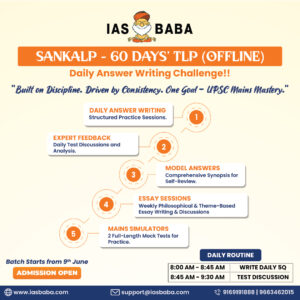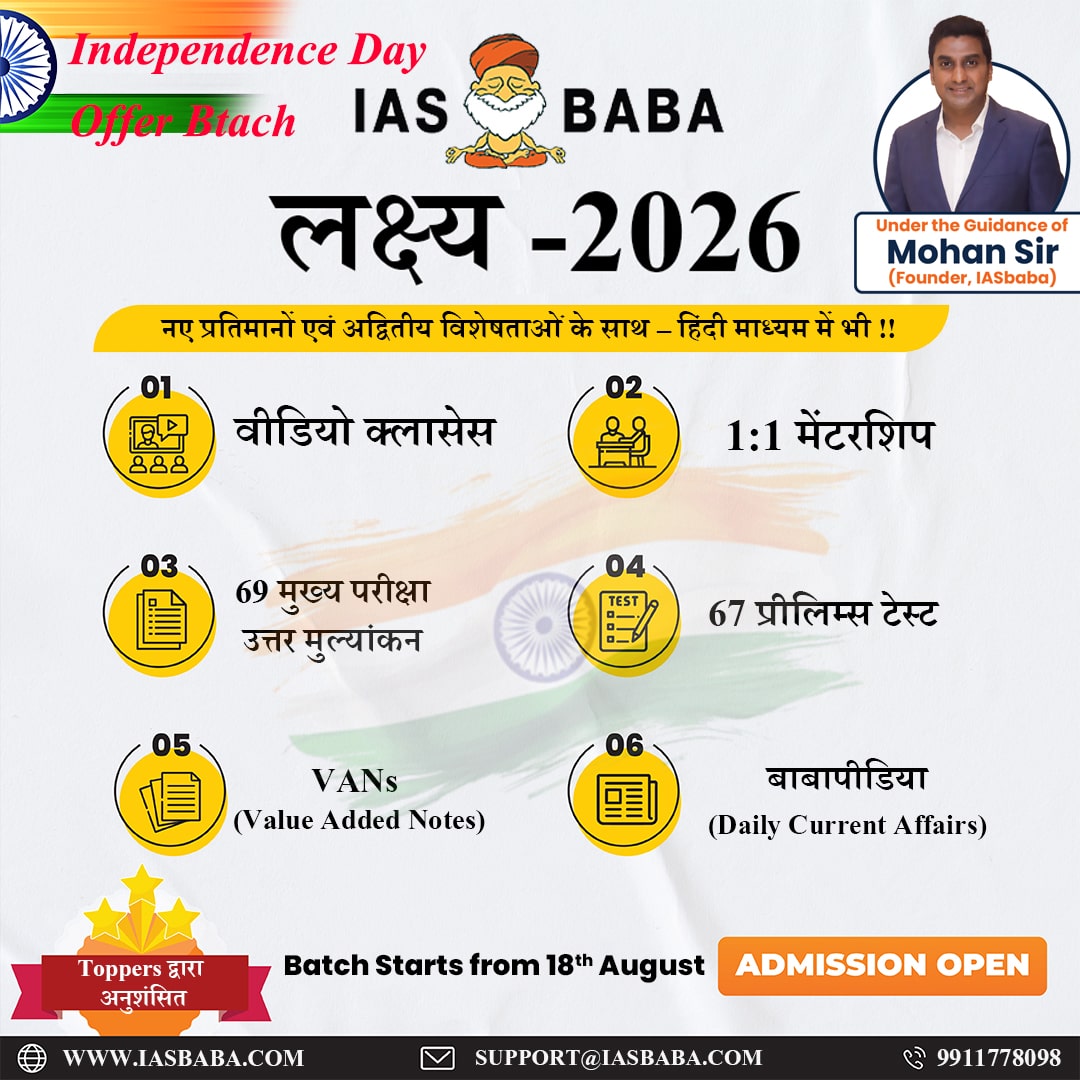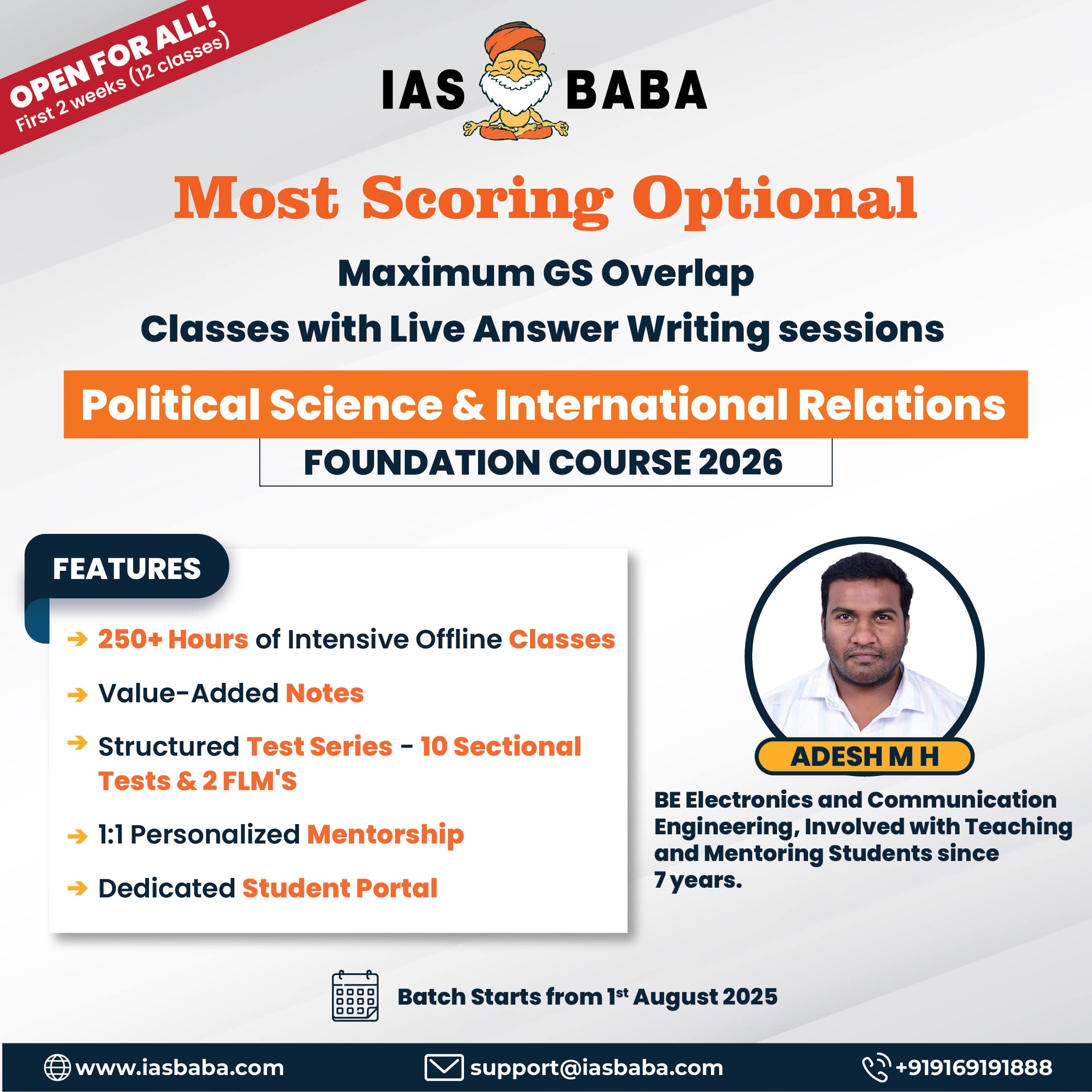IASbaba's Daily Current Affairs Analysis
Archives
(PRELIMS & MAINS Focus)
Category: ENVIRONMENT
Context: Mati Carbon, an Indian-led climate initiative has secured the $50 million grand prize in the XPRIZE Carbon Removal competition, outshining over 1,300 teams from 112 countries.
Decoding the context: Mati Carbon uses an Enhanced Rock Weathering (ERW) model, which captures carbon dioxide (CO2) while boosting crop yields for smallholder farmers. This offers a rare synergy of environmental and social impact.
Learning Corner:
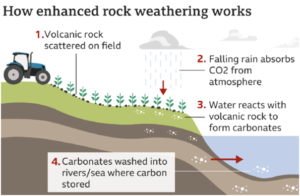
- Enhanced Rock Weathering (ERW) Model is a geoengineering technique that accelerates the natural weathering of silicate rocks (e.g., basalt) to capture atmospheric CO₂, converting it into stable bicarbonates or carbonates stored in soil, groundwater, or oceans for 10,000+ years.
- Process: Finely crushed basalt is spread on agricultural lands. CO₂ in rainwater reacts with the rock, forming bicarbonates that lock carbon away while releasing nutrients (calcium, magnesium) to enhance soil fertility.
- Benefits:
- Carbon Sequestration: Can remove 2-4 tonnes CO₂ per hectare annually; potential to scale to gigaton levels.
- Agricultural Gains: Increases crop yields by 20-25% by improving soil health; reduces fertilizer use.
- Climate Resilience: Benefits smallholder farmers in the Global South (e.g., India, Zambia) by addressing soil degradation.
- Additional Information – The XPRIZE Carbon Removal is a $100 million global competition funded by the Musk Foundation, aimed at incentivizing innovative solutions for carbon dioxide removal.
Source : Indian Express
Category: GEOGRAPHY
Context: India achieved a record 145.5 million tonnes cargo movement on inland waterways in FY 2024–25, up from 18.1 MMT in FY 2013–14, registering a CAGR of 20.86%.
Decoding the context: The Inland Waterways Authority of India (IWAI), under the Ministry of Ports, Shipping and Waterways, has expanded the number of National Waterways (NWs) from 5 to 111 under the National Waterways Act, 2016.
Learning Corner:
Overview of Inland Waterways
- India has 14,500 km of navigable waterways (rivers, canals, backwaters, creeks); 5,685 km are navigable by mechanized vessels.
- Managed by the Inland Waterways Authority of India (IWAI), formed in 1986 under the Inland Waterways Authority of India Act, 1985.
Infrastructure Development
- Operational Length: Expanded from 2,716 km in 2014–15 to 4,894 km in 2023–24.
- Key Initiatives:
- Construction of Multi-Modal Terminals (MMTs) and Inter-Modal Terminals (IMTs).
- Development of community jetties and floating terminals.
- Implementation of navigational locks and fairway maintenance.
- Jalvahak Scheme (2024): ₹95.42 crore budget; offers 35% reimbursement on operating costs to shift cargo to IWT; targets 800 million tonne-km diversion.
- Tonnage Tax (2025): Extended to inland vessels, reducing tax burden and encouraging adoption.
- Private Investment: National Waterways (Construction of Jetties/Terminals) Regulations, 2025, notified to attract private funds.
- Digital Solutions: CAR-D, PANI portals for ease of business; Naudarshika for navigation safety.
Key National Waterways in India
- National Waterway 1 (NW-1): Ganga-Bhagirathi-Hooghly River System
- Route: Haldia (West Bengal) to Prayagraj (Uttar Pradesh)
- Length: 1,620 km
- States Covered: West Bengal, Jharkhand, Bihar, Uttar Pradesh
- Significance: Longest national waterway; facilitates cargo movement between eastern and northern India.
- National Waterway 2 (NW-2): Brahmaputra River
- Route: Dhubri to Sadiya (Assam)
- State Covered: Assam
- Significance: Vital for connectivity in the Northeast; supports trade and transportation in Assam.
- National Waterway 3 (NW-3): West Coast Canal
- Route: Kottapuram to Kollam, including Champakara and Udyogmandal Canals (Kerala)
- State Covered: Kerala
- Significance: First waterway with all-weather navigability; crucial for cargo and passenger movement in Kerala.
- National Waterway 4 (NW-4): Godavari & Krishna Rivers and Canals
- Route: Kakinada (Andhra Pradesh) to Puducherry, NW-4 runs along the Coromandal Coast through Kakinada, Eluru, Commanur, Buckingham Canals and also through part of Krishna and Godavari rivers.
- States Covered: Andhra Pradesh, Telangana, Tamil Nadu, Puducherry
- Significance: Enhances connectivity in the southern states; supports agricultural and industrial transport.
Source : PIB
Category: GEOGRAPHY
Context: The death of Pope Francis has triggered a period of mourning across the globe, and tens of thousands of people flocked to the Vatican to pay their respects.
Decoding the context: Francis, the first Latin American pope in history, died at the age of 88.
Learning Corner:
- Vatican City, an independent city-state enclaved within Rome, Italy, is the smallest sovereign state in the world by area (44 hectares) and population (~800, 2025).
- Established by the Lateran Treaty (1929) between the Holy See and Italy, granting sovereignty to the Pope, who is both the spiritual leader of the Catholic Church and head of state.
Political Structure
- Government: Absolute monarchy; the Pope holds legislative, executive, and judicial powers.
- The Holy See (Sancta Sedes) is the central governing body of the Catholic Church and a distinct international legal entity; key bodies include the Secretariat of State and the Roman Curia.
- Legal System: Based on canon law, with the Pope as the supreme judge.
- Vatican City issues its own passports, coins (Euro), stamps, and license plates, but relies on Italy for defense.
Cultural and Religious Significance
- Religious Role: Spiritual center for Catholics; the Pope influences global moral and ethical issues.
- UNESCO Sites: Vatican City is a UNESCO World Heritage Site (1984) for its art, architecture (e.g., Michelangelo’s Pietà), and historical archives (Vatican Library, 75 km of shelving).
- Diplomacy: Maintains diplomatic relations with 183 countries (2025).
India-Vatican Relations:
- Diplomatic relations between India and The Holy See were established soon after India’s independence in 1948.
- In 2023, India and the Holy See celebrated the 75th anniversary of the establishment of bilateral diplomatic relations.
- India’s Ambassador to Austria, resident in Vienna, is concurrently accredited to the Holy See which maintains a Nunciature (Embassy) in New Delhi, presently headed by a Nuncio (Ambassador).
Source : CNN
Category: ENVIRONMENT
Context: The most intense global coral bleaching event on record is still ongoing, according to scientists. One year on from the official declaration of the fourth global coral bleaching event by the International Coral Reef Initiative (ICRI), bleaching alerts continue to develop across the world.
Decoding the context: The main cause of large-scale coral bleaching events is higher ocean temperatures. Last year was the hottest on record and the first to reach over 1.5°C warmer than pre-industrial times, due to human-induced climate change. This contributed to record-breaking ocean temperatures.
Learning Corner:
Coral Bleaching
- Corals have a symbiotic relationship with zooxanthellae (algae) that live in their tissues.
- These algae provide 90% of the coral’s energy through photosynthesis and give corals their color.
- When stressed, mainly due to elevated sea surface temperatures, corals expel the algae, turning white — this is coral bleaching.
- Bleached corals are not dead but are weakened and may die if stress continues.
- Causes: Primarily driven by marine heatwaves (ocean warming), ocean acidification, pollution, and overfishing; 2024 saw record ocean temperatures (1.5°C above pre-industrial levels).
Four Global Bleaching Events
- 1st Event (1998): Affected 21% of reefs; linked to El Niño; Great Barrier Reef (GBR) saw 50% bleaching.
- 2nd Event (2010): Impacted 37% of reefs; Indian Ocean reefs (e.g., Seychelles) lost 90% coral cover.
- 3rd Event (2014-2017): Hit 68% of reefs; GBR faced back-to-back bleaching (2016-17), losing 50% shallow-water corals.
- 4th Event (2023–Ongoing): Most intense; 84% reefs affected (82 countries) by March 2025; GBR saw 95% mortality in Acropora corals; Florida reefs hit 101°F (2023), causing near-total die-offs.
Source : ICRI
Category: POLITY
Context: Noting “the cross-border linkages of the terrorist attack” in Pahalgam on Tuesday (April 22) that led to the deaths of 26 people, the Cabinet Committee on Security (CCS) on Wednesday announced a series of extraordinary retaliatory measures against Pakistan.
Decoding the context: CCS meetings have been called during major events in India’s history, including the wars with Pakistan, the Kargil conflict and the Kandahar hijack.
Learning Corner:
What are Cabinet committees, in general?
- Following elections, once a Union Cabinet is sworn in and portfolios are allocated, the next step is the formation of the high-profile Cabinet committees. The Prime Minister sets up these committees with selected members of the Cabinet and assigns specific functions to these committees; both may later be modified.
- The membership of each committee varies from three to eight. Usually, only Cabinet ministers are members of these committees. If the Prime Minister himself is a member of any such committee, he acts as the head of that committee.
- There are eight Cabinet committees at present, including on issues such as Economic Affairs, Political Affairs, and Parliamentary Affairs. All committees except the Cabinet Committee on Accommodation and the Cabinet Committee on Parliamentary Affairs are headed by the PM.
Cabinet Committee on Security (CCS)
- The Cabinet Committee on Security (CCS) is the apex decision-making body in the Government of India on matters related to the country’s security, defence policy, and nuclear strategy.
- Members: Prime Minister (Chairperson), Minister of Defence, Minister of Home Affairs, Minister of Finance, Minister of External Affairs. Others like the NSA (National Security Advisor), Cabinet Secretary, or Chiefs of Armed Forces may be invited but are not permanent members.
Source : Indian Express
Practice MCQs
Q1.With reference to the Cabinet Committee on Security (CCS), consider the following statements:
- It is a statutory body under the Ministry of Defence.
- The National Security Advisor is a permanent member of the CCS.
- The CCS is chaired by the Prime Minister of India.
Which of the statements given above is/are correct?
A. 3 only
B. 1 and 2 only
C. 2 and 3 only
D. 1, 2, and 3
Q2.Consider the following statements about coral bleaching:
- Coral bleaching is a sign of coral death.
- The fourth global coral bleaching event has been linked to ocean warming caused by human-induced climate change.
- Coral reefs in India are protected only under the Wildlife Protection Act, 1972.
Which of the statements given above is/are correct?
A. 2 only
B. 2 and 3 only
C. 1 and 2 only
D. 1, 2, and 3
Q3.Consider the following statements:
- Vatican City is an absolute theocratic monarchy.
- The Holy See and Vatican City are the same and can be used interchangeably.
- Vatican City is a full member of the United Nations.
Which of the statements given above is/are correct?
A. 1 only
B. 1 and 3 only
C. 2 and 3 only
D. 1, 2, and 3
Comment the answers to the above questions in the comment section below!!
ANSWERS FOR ’ Today’s – Daily Practice MCQs’ will be updated along with tomorrow’s Daily Current Affairs
ANSWERS FOR 23 April – Daily Practice MCQs
Q.1) – b
Q.2) – b
Q.3) – c

